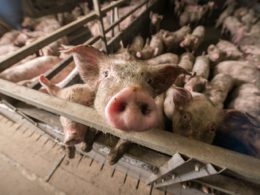 Many people don’t have to think much about where they get their food these days. It’s easy to go to the store and just pick up whatever you want. But in the Midwest, it’s hard to ignore the miles of fields that border the roads, and realize farmers are an invaluable asset to our country.
Many people don’t have to think much about where they get their food these days. It’s easy to go to the store and just pick up whatever you want. But in the Midwest, it’s hard to ignore the miles of fields that border the roads, and realize farmers are an invaluable asset to our country.
What do you envision when you think of a farmer? Even if you do live in the Midwest, the picture may not be flattering. But the reality is, with each passing year farming becomes even more technical and takes more intelligence than ever before.
Farming is not just about planting seeds and waiting for the crops to grow. Successful, large-scale farm work takes an in-depth knowledge of business, health and safety regulations, marketing, accounting, and of course knowing when to plant, protect the crops, and harvest. Even these skills also require some luck, because Mother Nature ultimately decides the outcome.
An example of the new generation of farming is 32-year old Johnny*, who lives on his own farm with his wife of the same age and their 2-year old daughter. Johnny works 2000 acres of land in a father-son partnership known as JDFarms. Johnny began working on his father’s farm when he was ten years old, but today makes most of the decisions regarding when to plant, buy and maintain equipment, spray crops, and harvest. His experience with farming is a lifelong commitment.
“When I was ten I would do anything I could such as driving a tractor or truck down the road to move equipment. I also helped bale hay and feed cattle. By twelve I could work dirt (plow) on my own. At fourteen or fifteen I started planting, and running the combine. When something broke down, I fixed it. I rebuilt a 350 Chevy engine that I put in my first truck. I continued to work on everything I could and learn as much as I could so I could maintain our farm equipment.
“When I started high school, I quit wrestling and football so I could devote as much time as possible to farming. I missed as many days of school as were allowed per semester during fall harvest and spring planting to get my own farming off the ground. I wanted to do a half-day and make my farming vocational, but it wasn’t allowed, so I stuck it out to get that diploma. As soon as I graduated high school I started farming full time.”
It is common at places such as the Indiana State Fair for pamphlets and coloring books to be given away that highlight safety for both children and their parents around the farm. As far as Johnny’s experiences, he has grain bins over 50 feet tall which he has to climb. He sometimes has to get inside the bins and must wear a respirator because of the risk of breathing mold. He’s been kicked by cattle, and has received many cuts and burns from working on farm equipment. The brakes even went out on a loaded grain truck he was driving downhill at age 17. He takes many precautions to keep both himself and his crops safe.
Knowledge of planting and harvesting times is essential. The average planting date for corn is April 20th, and for beans it’s May 1st. The weather can slow down progress if it’s a particularly snowy or rainy spring. Many people think the planting process is very simple: you just ride tractors through fields all day until you’re done, right? But there are even multiple techniques for this. Johnny says to make things go faster, you don’t have to plow. You can no-till, or plant directly into cork stalk or bean stubble from the prior year. You need a planter specifically set up to do so. “There is some merit to doing no-till. It depends on the season and how you want the seed-bed prepared for your planter. Each farmer does what works best for their farm. We’ve put some research into this and we like to cover each field twice before planting, once with a disc and once with a finisher. But you can also plant after only running the disc or the finisher if it’s overly wet and there’s no time to cover every field twice.”
During the planting and harvest times, Johnny usually works 16 hours a day. “There’s a very small window of time to get your crops in the ground, which will be a big factor in determining your income for the year. At different stages of growth, I check on my fields to see what stage of maturity they have reached, if they are showing any signs of stress from pests or lack of mineral in the ground, and as a projection later in the growing season as to what my yields might be.
“I need to have an idea on my yields because another large part of farming is marketing your grain. If you contract to sell more than you yield it ends up costing you. I get text messages daily from the Chicago Board of Trade on the prices of corn and soybeans. I also go to agweb.com daily, if possible, to keep up on any other pertinent information. As a farmer it’s important to pay close attention to world markets, and to supply and demand reports.”
The cost of seed, fertilizer, herbicide, pesticide, and maintaining equipment are split between Johnny and his father. Johnny’s wife (who has a degree in accounting) uses spreadsheets to make sure the cost and profits are accurate. This year there was a major drought in Indiana during the entire month of July. Johnny’s corn crop is expected to only produce half the usual yield, and his soybeans are not expected to do much better. Because of the severe lack of rain, he says, “Our earnings will most likely be cut in half, and we will be happy to break even.”
Herbicides and pesticides are a common concern today. Many people think they have to go organic to avoid being poisoned by their food. Johnny says he does use herbicides and pesticides. The crops he grows are used to make products such as corn flakes, corn syrup, and soybean oil, and are carefully regulated. “When you go to sell grain it’s tested for all kinds of things. No unsafe or chemically tainted grain is ever going to be allowed in the food because of the farmer. It’s tested at the elevator and if it doesn’t meet a certain standard, they don’t take it and we don’t get paid.
“Most pesticides and herbicides are made from other plants or flowers. They would be harmful if you drink them, but not when I’m spraying them. Warrior is a common pesticide. I also use herbicides such as Roundup, Harness, Atrazine, and Volunteer. If you didn’t use these, your yield would be greatly affected because the corn, beans, and wheat would be overgrown with weeds. We have to account for how much of each chemical is put on every acre. I have a chemical license, so I can buy these by attending a yearly class and receiving a certification on how to apply these properly. These are a few of the safety precautions farmers have to take to protect the non-farmer.”
Johnny also raises cattle. He used to run a dairy farm, but sold it out a few years ago. He is still familiar with dairy regulations, and says, “Your milk bulk tank is checked for any bacteria, antibiotics, hormones, or anything else before it’s picked up. If it doesn’t meet a certain standard they won’t take it. We took any and all precautions to make sure our milk was safe. Milk cows are fed a normal diet for a milk cow; we don’t give them anything to bolster milk production.”
When asked if USDA regulations are considered an annoyance or burden by farmers, Johnny says, “The regulations are not a hindrance. I just stay on top of what I need to do. I don’t think much could be done to make food safer at this point; the USDA strictly regulates it.”
Farming takes skill and business savvy to be successful. The people who grow our food deserve our appreciation, and for the rest of us to know what kind of intelligence the work really requires.
*Not his real name.












